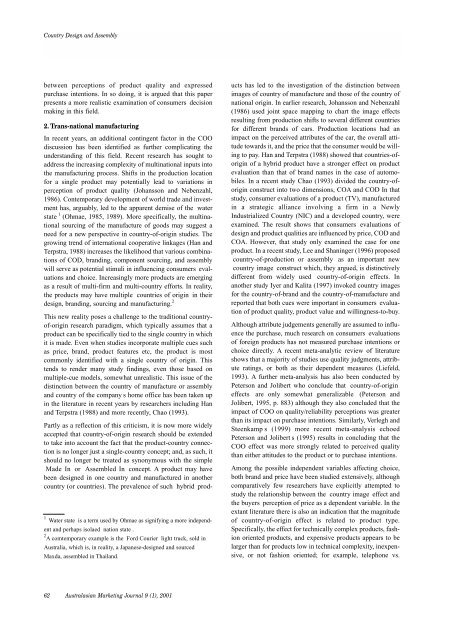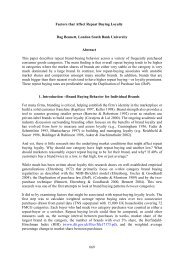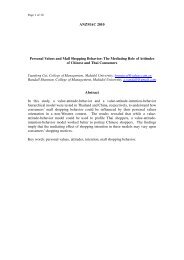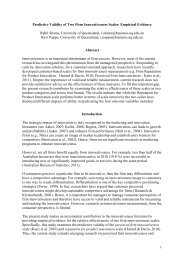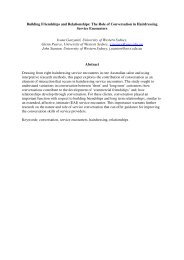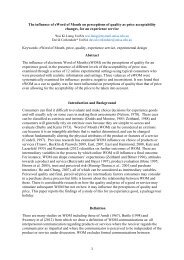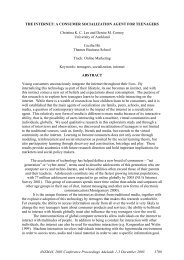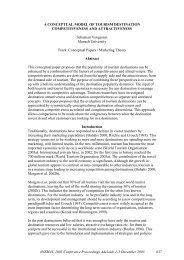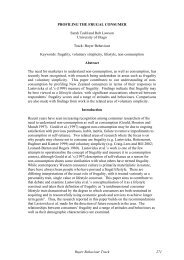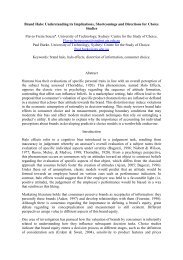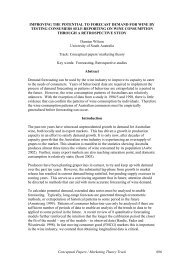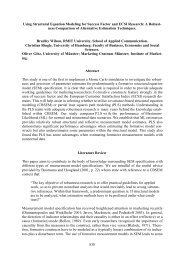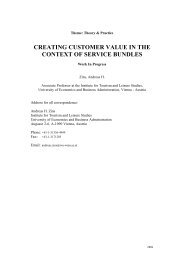amj Australasian Marketing Journal - ANZMAC
amj Australasian Marketing Journal - ANZMAC
amj Australasian Marketing Journal - ANZMAC
Create successful ePaper yourself
Turn your PDF publications into a flip-book with our unique Google optimized e-Paper software.
Country Design and Assembly<br />
between perceptions of product quality and expressed<br />
purchase intentions. In so doing, it is argued that this paper<br />
presents a more realistic examination of consumers decision<br />
making in this field.<br />
2. Trans-national manufacturing<br />
In recent years, an additional contingent factor in the COO<br />
discussion has been identified as further complicating the<br />
understanding of this field. Recent research has sought to<br />
address the increasing complexity of multinational inputs into<br />
the manufacturing process. Shifts in the production location<br />
for a single product may potentially lead to variations in<br />
perception of product quality (Johansson and Nebenzahl,<br />
1986). Contemporary development of world trade and investment<br />
has, arguably, led to the apparent demise of the water<br />
state 1 (Ohmae, 1985, 1989). More specifically, the multinational<br />
sourcing of the manufacture of goods may suggest a<br />
need for a new perspective in country-of-origin studies. The<br />
growing trend of international cooperative linkages (Han and<br />
Terpstra, 1988) increases the likelihood that various combinations<br />
of COD, branding, component sourcing, and assembly<br />
will serve as potential stimuli in influencing consumers evaluations<br />
and choice. Increasingly more products are emerging<br />
as a result of multi-firm and multi-country efforts. In reality,<br />
the products may have multiple countries of origin in their<br />
design, branding, sourcing and manufacturing. 2<br />
This new reality poses a challenge to the traditional countryof-origin<br />
research paradigm, which typically assumes that a<br />
product can be specifically tied to the single country in which<br />
it is made. Even when studies incorporate multiple cues such<br />
as price, brand, product features etc, the product is most<br />
commonly identified with a single country of origin. This<br />
tends to render many study findings, even those based on<br />
multiple-cue models, somewhat unrealistic. This issue of the<br />
distinction between the country of manufacture or assembly<br />
and country of the company s home office has been taken up<br />
in the literature in recent years by researchers including Han<br />
and Terpstra (1988) and more recently, Chao (1993).<br />
Partly as a reflection of this criticism, it is now more widely<br />
accepted that country-of-origin research should be extended<br />
to take into account the fact that the product-country connection<br />
is no longer just a single-country concept; and, as such, it<br />
should no longer be treated as synonymous with the simple<br />
Made In or Assembled In concept. A product may have<br />
been designed in one country and manufactured in another<br />
country (or countries). The prevalence of such hybrid prod-<br />
1<br />
Water state is a term used by Ohmae as signifying a more independent<br />
and perhaps isolaed nation state .<br />
2<br />
A comtemporary example is the Ford Courier light truck, sold in<br />
Australia, which is, in reality, a Japanese-designed and sourced<br />
Maxda, assembled in Thailand.<br />
62 <strong>Australasian</strong> <strong>Marketing</strong> <strong>Journal</strong> 9 (1), 2001<br />
ucts has led to the investigation of the distinction between<br />
images of country of manufacture and those of the country of<br />
national origin. In earlier research, Johansson and Nebenzahl<br />
(1986) used joint space mapping to chart the image effects<br />
resulting from production shifts to several different countries<br />
for different brands of cars. Production locations had an<br />
impact on the perceived attributes of the car, the overall attitude<br />
towards it, and the price that the consumer would be willing<br />
to pay. Han and Terpstra (1988) showed that countries-oforigin<br />
of a hybrid product have a stronger effect on product<br />
evaluation than that of brand names in the case of automobiles.<br />
In a recent study Chao (1993) divided the country-oforigin<br />
construct into two dimensions, COA and COD In that<br />
study, consumer evaluations of a product (TV), manufactured<br />
in a strategic alliance involving a firm in a Newly<br />
Industrialized Country (NIC) and a developed country, were<br />
examined. The result shows that consumers evaluations of<br />
design and product qualities are influenced by price, COD and<br />
COA. However, that study only examined the case for one<br />
product. In a recent study, Lee and Shaninger (1996) proposed<br />
country-of-production or assembly as an important new<br />
country image construct which, they argued, is distinctively<br />
different from widely used country-of-origin effects. In<br />
another study Iyer and Kalita (1997) invoked country images<br />
for the country-of-brand and the country-of-manufacture and<br />
reported that both cues were important in consumers evaluation<br />
of product quality, product value and willingness-to-buy.<br />
Although attribute judgements generally are assumed to influence<br />
the purchase, much research on consumers evaluations<br />
of foreign products has not measured purchase intentions or<br />
choice directly. A recent meta-analytic review of literature<br />
shows that a majority of studies use quality judgments, attribute<br />
ratings, or both as their dependent measures (Liefeld,<br />
1993). A further meta-analysis has also been conducted by<br />
Peterson and Jolibert who conclude that country-of-origin<br />
effects are only somewhat generalizable (Peterson and<br />
Jolibert, 1995, p. 883) although they also concluded that the<br />
impact of COO on quality/reliability perceptions was greater<br />
than its impact on purchase intentions. Similarly, Verlegh and<br />
Steenkamp s (1999) more recent meta-analysis echoed<br />
Peterson and Jolibert s (1995) results in concluding that the<br />
COO effect was more strongly related to perceived quality<br />
than either attitudes to the product or to purchase intentions.<br />
Among the possible independent variables affecting choice,<br />
both brand and price have been studied extensively, although<br />
comparatively few researchers have explicitly attempted to<br />
study the relationship between the country image effect and<br />
the buyers perception of price as a dependent variable. In the<br />
extant literature there is also an indication that the magnitude<br />
of country-of-origin effect is related to product type.<br />
Specifically, the effect for technically complex products, fashion<br />
oriented products, and expensive products appears to be<br />
larger than for products low in technical complexity, inexpensive,<br />
or not fashion oriented; for example, telephone vs.


